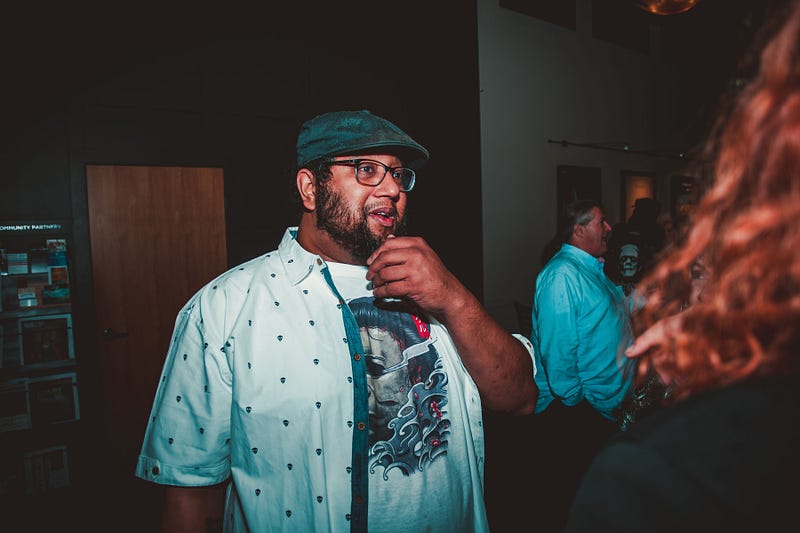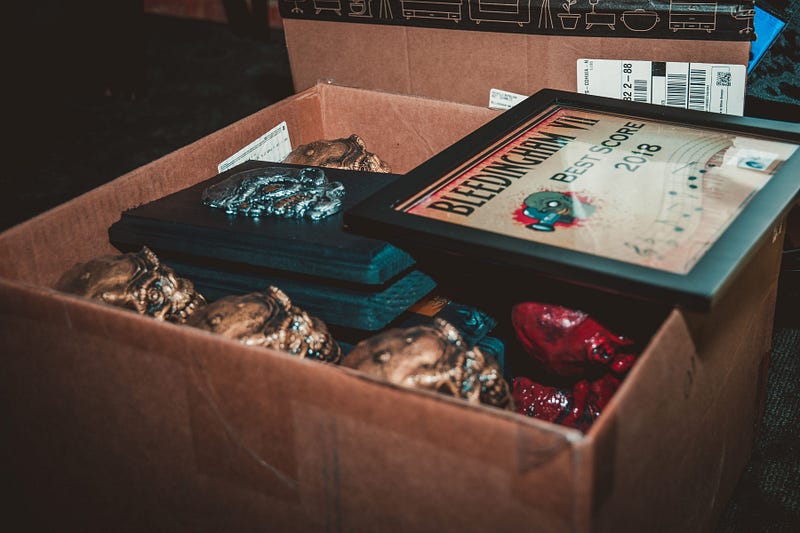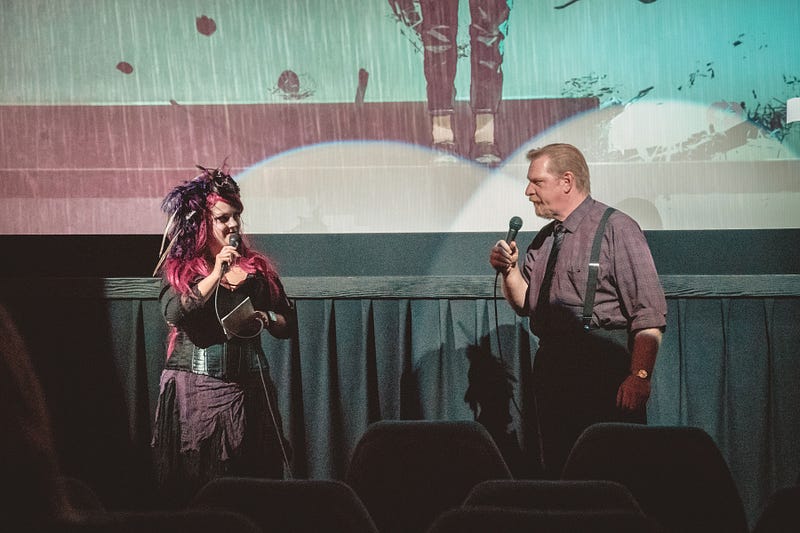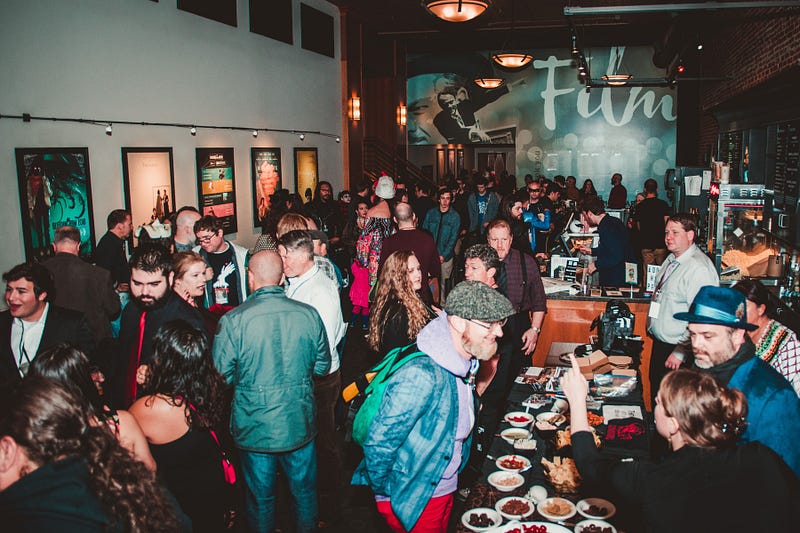Bellingham, Blood and B-Movies

Looking at ten years of Bleedingham and to the film festival’s future.
Story by Benjamin Leung
Halloween Weekend, October 2018
Filmmakers and visitors crowd the reception of the Pickford Film Center, a local movie theater set in the streets of downtown Bellingham. Attendees dress in a wide range of attire — formalwear to streetwear — socializing and enjoying free appetizers and desserts stacked atop tables. Vendors sell artwork — paintings of cats dressed as iconic slasher killers like Jason Voorhees, clothing, animal bone sculptures, paintings, books and more. At the entrance, photographers flash pictures of the arriving filmmakers.
“Even though it’s not like Hollywood red carpet, it feels that,” said Crystal Connor, one of Bleedingham’s nine competitive film judges and professional horror novelist.
As the main event starts, attendees stream into one of two auditoriums at shoulder-to-shoulder capacity. Co-hosts Langley West and Jackie Kersten step out to entertain the audience and introduce the films.
Silence settles as projectors light the screens with the year’s submissions.
The Beginning
His last year at Western, Gary Washington attended a film festival at the Pickford celebrating hip-hop.
“They had a live performer. They’re rapping, and he was the most audacious rapper with terrible lyrics,” Washington said. “And he was humping [a few people including me, nonconsensually].”
Uncomfortable, Washington and his friends decided to leave and have drinks at the Grand Avenue Ale House instead.
“Man, I wouldn’t disrespect the Pickford like that, you know,” Washington said to his friends at The Grand. “I’d have my own festival. We’d call it… Bleedingham!”
“Well Gary, that actually sounds like a cool idea,” said one of Washington’s friends.

Having moved from Las Vegas to Washington state, filmmaker Langley West buzzed local filmmakers for help on a personal project.
Gary Washington responded.
Working together, Washington and West realized they both loved the horror genre, exchanging references to The Night Gallery, the Alien franchise, Tom Savini — general film geek stuff and the beginning of a friendship, according to West.
“The Night Gallery was a TV show in the early 70s hosted by Rod Serling and we both were huge fans of that,” West said. “That was one of those things, at least back then, whenever you’d tell somebody, ‘remember The Night Gallery?’ and they said, ‘yeah,’ it’s like, okay, secret code. Boom!”
Washington and West maintained a working partnership on a number of paid jobs and in a monthly competition at The Pickford called Trailer Wars.
“One of the things that I really enjoyed when I first moved to Bellingham was the thriving film community, but there wasn’t a lot of fun, and everybody was very involved in social justice things and things like that,” West said.
“We were like, let’s do something [where] people can just … let their hair down and have a good time, at the same time developing their skills.”
The two men teamed with Casey Schmidt, founder of Northwest Grip, to make Bleedingham a reality, eyeing the Pickford as the venue.
Bleedingham received 13 submissions of short horror films in its first year and tickets sold out.
“We were scared to death. We had no idea if we could pull it off,” West said. “I remember I was making trophies and things literally outside of the theater as the show was going on, trying to get things finished.”
A majority of Bleedingham’s earliest entries looked amateurish due to the equipment and resources available to the micro-budget filmmakers, according to West.
“We were making Bleedingham with a DSLR Camera … whatever blood you could find from the local store, ketchup or something you found online with chocolate syrup … and that was the first couple of years,” Washington said.

Ten Years Later
After seven years as a judge, Crystal Connor continues to dedicate months of her life to watching and critiquing the hundreds of submissions Bleedingham receives annually. And the number increases every year.
A published author of 13 novels and film critic for HorrorAddicts.net, Connor was at her booth at Crypticon Seattle — a horror genre convention — when Washington approached and asked her to judge submissions for Bleedingham.
“He gave me his card and then I looked him up online and I was like, ‘Oh, my God, this guy is a big deal,’” Connor said. “My first year working with Bleedingham was like, ‘I need to impress him so I can stay part of this project. I don’t want to get kicked out. I don’t want to blow it.’ And … I didn’t. And I’m still here.”
In her time serving the event, she’s watched the film festival expand its scope from a focus on filmmakers in the Pacific Northwest, to international submissions, including films from Iran, Egypt and China.
As a competition, Bleedingham’s core systems — film categories, ranking and rubrics — have undergone significant development and tuning.
“The first one … we were trying to build the system. We didn’t know what the system needed to be,” West said. “Now, in comparison we have our cadre of judges, … we use an online system for them to see the films and vote. It’s much easier because we just have to plug in the new [films] every year.”

Back in the day, West remembers having to assemble all of the judges at a house to screen the submissions in the living room and afterwards, sorting through stacks of judges’ notes written on paper.
Though Bleedingham is competitive in structure, its founders have maintained that it’s all about helping the filmmakers improve as filmmakers. West and Washington emphasized the importance of choosing judges involved in the creative industry, whether as filmmakers, writers or film composers to provide participants with feedback from industry veterans.
“It didn’t matter if you were a professional or if you were a rank amateur, if you were a kid and all you had access to was … the video function on your cell phone. Everybody could compete,” West said. “But that also meant, you know, giving feedback that said, ‘Hey, you know, I like your story, but … your lighting is really bad.’ And as that feedback … came in, people listened to it, and they started upping their game.”
Connor says she sees Bleedingham’s film submissions improve every year.
“Every year, the film quality and depth and storylines and plots [gets] better and better,” Connor said. “Some of these short films look like [they] were produced with like a million dollar budget.”
West and Connor attributed the improvements in visual quality partially to advancements in filmmaking technology and accessibility to equipment.
“When we first started, it was a big deal if you shot something on a digital red camera,” West said. “Well now, that’s not that big of a deal, and so consequently, the films look fantastic.”
Film professor and author of “The Revolting Child in Horror Cinema: Youth Rebellion and Queer Spectatorship,” Andrew Scahill said advancements in technology have historically shifted and continue to change the filmmaking landscape.
“We think that shifts in art happen just out of like … brilliant ideas or people being avant garde,” Scahill said. “A lot of it happens because of technology.”
According to Scahill, technological innovators like handheld footage that push the envelope of filmmaking have a democratizing effect on the artform. He pointed to “Host,” a horror film recorded entirely on Zoom in the midst of the pandemic.

In addition to improvements in technology and accessibility, Washington says Bleedingham has seen more and more films addressing social justice, culture and new types of fears.
“Last year, there was a film … about a fabric that was cursed because it was picked under inhumane conditions. The way that they translated that, … they literally had you, with sound design, feeling like your skin was getting stitched,” Washington said. “What we’re seeing is a lot more use of metaphors, … intangible type concepts.”
According to Scahill, the modern slashers have traded physical threats like Jason Voorhees for intangible forces like fate in Final Destination or the puppeteers of the Saw franchise — speaking to a generation of millennials feeling demoralized about creating systemic change.
As for the recent slower-burn horror, according to Scahill, genres naturally cycle as new films innovate and others imitate, until the next innovation shifts the genres gears again.
“As we go along, when we’re getting films like Hereditary and Midsommar from A24, … we have seen the films start to change as they’re coming in and be a little more thoughtful and … thought provoking.” West said.
International horror provides reflections of foreign social turmoils and new approaches to the genre, Scahill said, using the Japanese concept of a haunting as a sickness as an example.
“It’s interesting now that we’re judging films from all over the world to see how horror affects different people from different cultures,” Connor said.

Washington sees independent filmmaking continuing to become more prevalent as technology improves and becomes more accessible to marginalized communities.
“In the age of YouTube and stuff, I think that [the] independent filmmaking [model] is going to be the entire vessel in which content is created,” Washington said. “You already seen it now, … Hollywood films [are] losing out to like streamers … and web shows. It’s like, … how long before the blockbuster summer film model goes?”
According to Scahill, the studio model in Hollywood behaves as a loan shark system, creating a risk-averse environment for filmmakers that discourages innovation like diversity in casting, unless proven successful in the market. Independent films, especially short films, have less money on screen, enabling the filmmakers to more willingly take creative risks.
“They’re not put in boxes by … producers or big-time directors,” Connor said of independent filmmakers. “They’re able to stay completely true to their story and tell it the way they envision it.”
“Short films … because of the sort of low money involved, can be the most intimate,” Scahill said. “You’re not putting $200 million of someone else’s money on the line, you are doing a passion project, funded by yourself and … your crew.”
In 2020, Rose Jones, a lifelong horror enthusiast purchased tickets for Bleedingham’s virtual screening, having never attended the in-person event because she lives in Tacoma. At her leisure, she watched every film on her desktop, at home, fixing dinner and completing chores in-between films.
“I don’t know if these are all professional or amateur … directors and producers and stuff, but they all did a good job. They really did,” Jones said.
Bleedingham’s Future
“I [see] this festival getting as big as … maybe South by Southwest or like … Sundance festival, because of the amazing amount of talent that’s being submitted … and just the way it’s been growing … that other small film festivals haven’t,” Connor said. “I’m just happy to be a part of Bleedingham. This is like a family.”

Right now, Washington plans to turn Bleedingham into a nonprofit organization in order to bring in new people to help chart the course of the festival for the next 10 years, as well as recognize the work of those helping run the festival.
“Now that we have this much time invested in it and we are trying to do bigger things like the nonprofit, it feels more… I don’t want to say it feels like a business, but it feels more important than just play,” West said. “So yes, it’s fun, but it’s also a lot of work, and we want to … present our best face and we want to be taken seriously.”
At the end of the day, as Bleedingham continues to evolve and expand, Washington says they remain focused on maintaining and developing its relationships with the Bellingham community and the film community at large.
“We don’t ever want to lose sight that this is an exercise, an opportunity for our local community to do storytelling on their own and present it,” Washington said.
